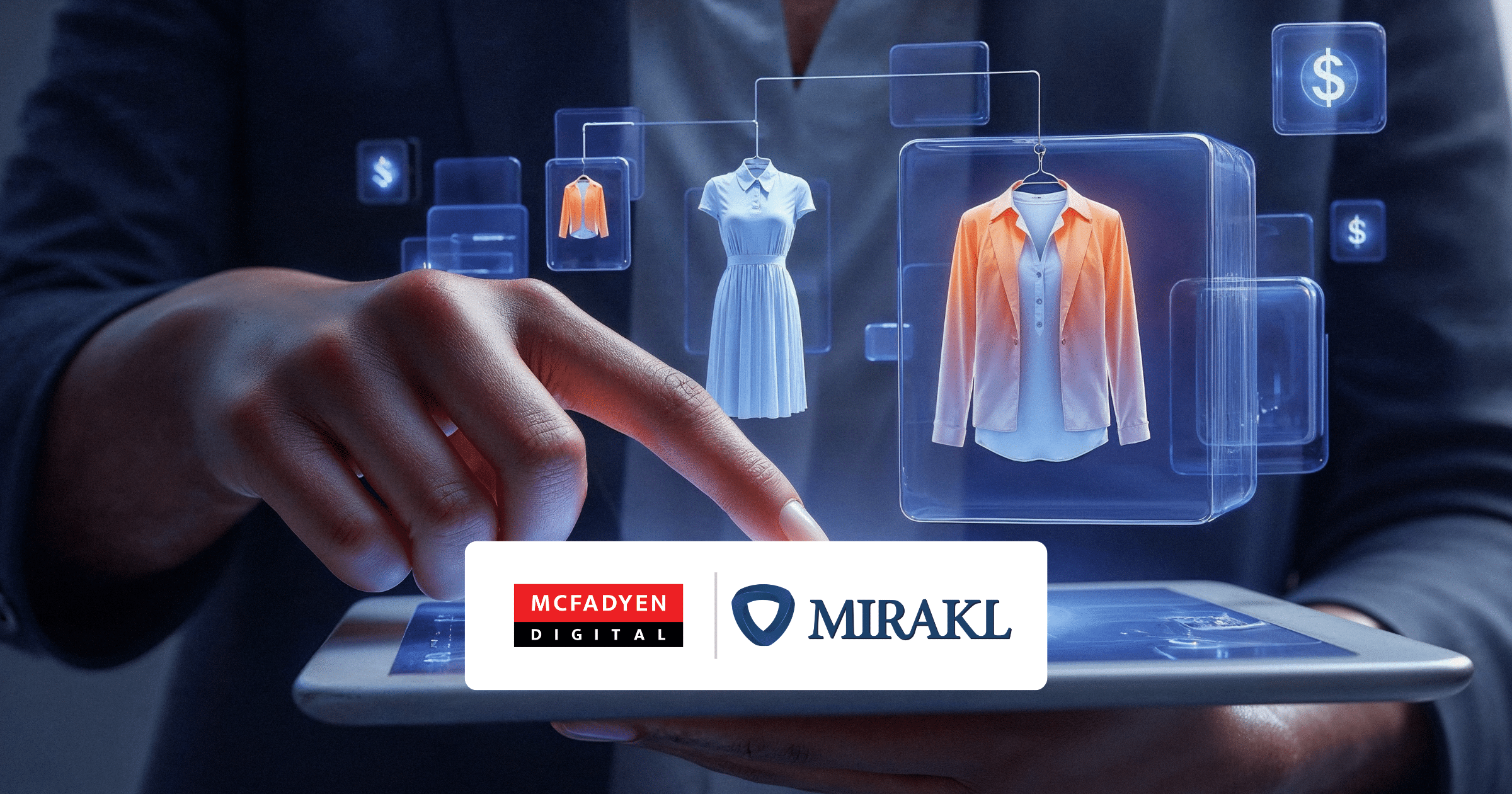
Wholesale distributors face unprecedented pressure to modernize. Professional buyers expect seamless, self‑service digital experiences, while marketplace leaders raise the competitive bar. Standing still risks customer attrition and margin erosion, whereas modernization delivers growth, efficiency, and agility. This post outlines the new rules of B2B commerce, the risk of delay, and a pragmatic path to modernization—supported by McFadyen Digital case examples and frameworks—so leaders can reduce risk while accelerating impact.
The Bar Has Moved: Digital Self‑Service, Omnichannel, Personalization
B2B buying has become decisively digital. Gartner projects that by 2025 80% of B2B sales interactions between suppliers and buyers will occur in digital channels. Forrester likewise forecasts that in 2025 more than half of large B2B purchases (US$1M+) will be processed through digital self‑serve channels such as vendor websites and marketplaces. Buyers prefer frictionless research, evaluation, and purchasing—bringing sales in where they add the most value.
Omnichannel is the expectation. Customers fluidly move between web, mobile, chat, phone, and field interactions, yet expect a unified experience across all of them. Gartner’s “Future of Sales” guidance notes buyers spend relatively little time with suppliers directly (often cited as ~17% of the total journey), elevating the importance of digital content and tools that enable confident decisions. Salesforce’s B2B trends analysis similarly underscores the pivot to digital channels and the need for composability to deliver faster, more tailored experiences.
Personalization is table stakes. Forrester’s 2024 B2B personalization research highlights that buyers expect relevant, context‑aware interactions throughout the lifecycle, and its practitioner guidance emphasizes an audience‑centric approach that prioritizes buyer value over generic tactics.
Disruption from Marketplaces and Digital‑First Competitors
Marketplace operators and digital‑native competitors are redefining speed, choice, and convenience. Amazon Business alone has surpassed ~$35B in annualized sales, bringing B2C‑caliber UX patterns—streamlined search, social proof, fast delivery—into B2B contexts. Beyond Amazon, specialist B2B marketplaces and digitally savvy wholesalers win by making complex buying simple: expanding assortment, increasing transparency, and compressing cycle times. McFadyen’s internal Marketplace Best Practices outline how marketplaces change the rules for assortment, pricing power, and scale, and why distributors need both offense‑and‑defense strategies.
Case Example — Bay Supply
Rather than compete on legacy terms, Bay Supply launched an online marketplace in the fasteners vertical and invested in Marketplace Performance Management (MPM) analytics to unify data across channels. Using a six‑week prototype, the team consolidated marketplace KPIs—sales trends, seller performance, buyer behavior—into a single Power BI dashboard to guide action. The result: faster, data‑driven decisions about product mix, seller enablement, and customer experience—turning data into a competitive weapon against larger rivals.
The Risk of Standing Still vs. the Benefits of Modernization
Risks of inaction. Distributors that delay modernization face rising customer churn (as buyers default to easier digital options), shrinking wallet share (as long‑tail orders flow to marketplaces), margin erosion (from manual, error‑prone processes), and an innovation gap that compounds over time. Given buyers’ digital‑first posture, outdated portals, slow quoting, and inconsistent cross‑channel experiences become direct headwinds to growth.
Benefits of modernization. Modern platforms and data practices unlock acquisition and retention (discoverability, self‑service, great CX), revenue growth (cross‑sell/upsell, targeted promotions, account‑based experiences), efficiency (automation, integration, straight‑through processing), and agility (rapidly launching new capabilities like marketplaces or new channels). With buyers researching independently and engaging sellers selectively , a modern digital core ensures you’re relevant when it matters.
New Rules of B2B Commerce → Modernization Benefits
| New Rule / Expectation | Modernization Benefit |
|---|---|
| Digital Self‑Service is Expected | |
| (>50% of large B2B transactions via self‑serve by 2025 [2]; 80% of interactions digital by 2025 [1]) | Scale & Capture Demand: 24/7 commerce and quote‑to‑order flows meet buyers where they are; sellers focus on high‑value moments. |
| Omnichannel Consistency | |
| (Buyers traverse web, mobile, chat, phone, field—expecting unity [3][4]) | Loyalty & Trust: Unified pricing, availability, content, and entitlements reduce friction and churn while improving satisfaction. |
| Personalized, Consumer‑Grade UX | |
| (B2B buyers expect relevant, context‑aware experiences [5][6]) | Higher Win Rates: Relevant catalogs, recommendations, and content increase engagement and conversion while respecting preferences. |
| Marketplace Dynamics | |
| (Scale, assortment, and convenience reset expectations [8][9]) | Parity/Advantage: Broaden assortment (own marketplace/third‑party), add dynamic pricing, and improve fulfillment speed. |
| Data‑Driven Decisions | |
| (Real‑time KPIs inform actions across the funnel [12][13]) | Smarter Operations: Optimize catalog, pricing, and seller enablement; detect issues early; iterate faster with evidence. |
McFadyen’s POV: How to Modernize with Less Risk
- Strategic roadmapping & phased delivery. Start with an intensive Discovery to align goals, surface risks, and prioritize capabilities; each hour invested upfront saves multiples later via reduced rework and faster time‑to‑value. Deliver value in increments (e.g., core eCommerce first; personalization/marketplace next) with pilots, parallel runs, and measurable KPIs.
- Composable, flexible architecture. Integrate and reuse what works (ERP, PIM/MDM, OMS) and replace only what truly needs replacing—using APIs and event‑driven patterns to decouple experiences from transactions. This hybrid approach delivers a modern UX without a risky rip‑and‑replace and remains future‑ready for new channels and capabilities.
- Accelerators & reusable assets. The SmartLaunch accelerator for BigCommerce B2B Edition provides pre‑configured B2B capabilities to shorten time‑to‑market, reduce integration cost, and lower TCO—while preserving extensibility for unique requirements.
- Change management & enablement. Modernization is a people project. Engage stakeholders early, train users, and cultivate champions to speed adoption and ROI.
- Proven delivery patterns & lessons learned. Programs like Radwell International’s EU modernization illustrate practical risk mitigation—e.g., adding Hyvä UI expertise on demand, addressing PM turnover with structured knowledge transfer, and sequencing integrations to protect timelines. One‑pager highlights summarize the multi‑region launch and performance/search improvements.
Conclusion: Modernize Now or Fall Behind
The new rules of B2B commerce favor distributors who act decisively. Buyer behavior, channel dynamics, and competitive pressure won’t pause. The risk of waiting exceeds the risk of moving—especially with a phased approach, accelerators, and strong governance. Pair traditional strengths (industry know‑how, service, relationships) with digital excellence to outperform digital natives and marketplaces alike. Modernize now—your customers, your margins, and your future optionality will thank you.
Related Articles
Turn Insight Into Impact.
Start Today.



